Understanding the Impact of Human Mobility Patterns on Taxi Drivers’ Profitability Using Clustering Techniques: A Case Study in Wuhan, China
Abstract
:1. Introduction
2. Methodology
2.1. Data Description and Pre-Processing
2.2. The Methodology of the Mobility Patterns of Taxi Drivers’ Profitability Levels
2.2.1. A Method for Taxi Drivers’ Classification Based on their Profitability
2.2.2. A Method for Extracting Cruising Trips and Stopping Spots
2.2.3. Mobility Patterns of Cruising Trips and Stopping Spots
| Algorithm 1: DBSCAN algorithm in our study. |
| Input: points (stopping spots), EPS, MinPts |
| Output: clusters set C |
| 1: C = null; 2: for each unvisited point p in points 3: mark p as visited; 4: obtain p’s EPSNeighborhood within EPS using spherical law of cosines method as in Formula (1); 5: if | p’s EPSNeighborhood|< MinPts, then mark p as a noise point; 6: else set C as a new cluster and add p to cluster C; 7: for each point q in p’s EPSNeighborhood 8: if q unvisited, mark q as visited obtain q’s EPSNeighborhood by EPS similar to Step 4; 9: if |q’s NeighborPts| ≥ MinPts 10: p’s EPSNeighborhood = p’s EPSNeighborhood joined with q’s EPSNeighborhood 11: end if 12: end if 13: if q is not yet member of any cluster, then add q to cluster C; 14: end if 15: end for 16: end if 17: obtain the cluster center of C using Formula (10) 18: end for |
3. Results
3.1. Classification and Occupancy Ratio of Taxi Drivers with Three Driving Profitability Groups
3.2. Extracting Cruising Trips and Stopping Spots of Three Profitability Levels
3.3. Spatial and Temporal Patterns of Cruising Trips
3.4. Spatial and Temporal Patterns of Stopping Spots with Three Profitability Levels
3.4.1. General Temporal Patterns
3.4.2. Spatial and Temporal Patterns of Stopping Spots of Longer Durations
3.4.3. Spatial and Temporal Patterns of Stopping Spots in Off-Peak Duration
4. Discussion
4.1. Discussion of the Findings
4.2. Comparison with Similar Studies
5. Conclusions
Acknowledgments
Author Contributions
Conflicts of Interest
References
- Wuhan Transportation Development Strategy Research. 2013 Wuhan Transportation Development Annual Report. Available online: http://www.wpl.gov.cn/pc-1516-51822.html. (accessed on 15 June 2016).
- Yuan, J.; Zhang, Y.; Zhang, L.H.; Xie, X.; Sun, G.Z. Where to find my next passenger. In Proceedings of the 17th ACM SIGKDD International Conference on Knowledge Discovery and Data Mining, San Diego, CA, USA, 21–24 August 2011; pp. 109–118. [Google Scholar]
- Occupational Employment Statistics. Occupational Employment and Wages. Taxi Drivers and Chauffeurs. Available online: http://www.bls.gov/oes/current/oes533041.htm#(2) (accessed on 3 Septmber 2016).
- Driven Into Poverty A Comprehensive Study of the Chicago Taxicab Industry. Available online: https://ler.illinois.edu/wp-content/uploads/2015/01/Taxi-Income-Report-Final-Copy1.pdf (accessed on 15 December 2016).
- Liang, L.; Andris, C.; Biderman, A.; Ratti, C. Revealing taxi drivers mobility intelligence through his trace. In Movement-Aware Applications for Sustainable Mobility: Technologies and Approaches; Information Science Reference: New York, NY, USA, 2010; pp. 105–120. [Google Scholar]
- Xu, T.; Zhu, H.S.; Zhao, X.Y.; Liu, Q.; Zhong, H. Taxi Driving Behaviour Analysis in Latent Vehicle-to-Vehicle Networks: A Social Influence Perspective. In Proceedings of the 22nd ACM SIGKDD International Conference on Knowledge Discovery and Data Mining, San Francisco, CA, USA, 13–17 August 2016; pp. 1285–1294. [Google Scholar]
- Yang, W.X.; Wang, X.; Rahimi, S.M.; Luo, J. Recommending Profitable Taxi Travel Routes Based on Big Taxi Trajectories Data. In Proceedings of the Pacific-Asia Conference on Knowledge Discovery and Data Mining, Minh City, Vietnam, 19–22 May 2015; pp. 370–382. [Google Scholar]
- Powell, J.W.; Huang, Y.; Bastani, F.; Ji, M. Towards reducing taxicab cruising time using spatio-temporal profitability maps. In Proceedings of the 12th International Symp. Spatial Temporal Databases, Minneapolis, MN, USA, 24–26 August 2011; pp. 242–260. [Google Scholar]
- Gao, Y.; Xu, P.P.; Lu, L.; Liu, H.; Liu, S.Y.; Qu, H.M. Visualization of Taxi Drivers' Income and Mobility Intelligence. In Proceedings of the 2012 International Symposium on Visual Computing (ISVC), Rethymnon, Greece, 16–18 July 2012; pp. 275–284. [Google Scholar]
- Zhu, B.; Xu, X. Urban Principal Traffic Flow Analysis Based on Taxi Trajectories Mining. In Advances in Swarm and Computational Intelligence; Springer: New York, NY, USA, 2015; pp. 172–181. [Google Scholar]
- Ding, L.F.; Fan, H.C.; Meng, L.Q. Understanding Taxi Driving Behaviours from Movement Data. In Agile; Springer: New York, NY, USA, 2015; pp. 219–234. [Google Scholar]
- Ding, L.F.; Yang, J.; Meng, L.Q. Visual Analytics for Understanding Traffic Flows of Transport Hubs from Movement Data. In Proceedings of the International Cartographic Conference, Rio de Janeiro, Brazil, 19–21 August 2015; pp. 23–28. [Google Scholar]
- Kumar, D.; Wu, H.Y.; Lu, Y.; Krishnaswamy, S.; Palaniswami, M. Understanding Urban Mobility via Taxi Trip Clustering. In Proceedings of the 17th IEEE International Conference on Mobile Data Management (MDM), Porto, Portugal, 13–16 June 2016; pp. 318–324. [Google Scholar]
- Chen, C.; Zhang, D.Q.; Li, N.; Zhou, Z.H. B-Planner: Planning bidirectional night bus routes using large-scale taxi GPS traces. IEEE Trans. Intell. Transp. Syst. 2014, 15, 1451–1465. [Google Scholar] [CrossRef]
- Chen, C.; Zhang, D.Q.; Li, N.; Zhou, Z.H. B-Planner: Night bus route planning using large-scale taxi GPS traces. In Proceedings of the IEEE International Conference on Pervasive Computing and Communications, San Diego, CA, USA, 18–22 March 2013; pp. 225–233. [Google Scholar]
- Shen, Y.; Zhao, L.G.; Fan, G. Analysis and Visualization for Hot Spot Based Route Recommendation Using Short-Dated Taxi GPS Traces. Information 2015, 6, 134–151. [Google Scholar] [CrossRef]
- Chang, H.W.; Tai, Y.C.; Hsu, J.Y. Context-aware taxi demand hotspots prediction. Int. J. Bus. Intell. Data Min. 2010, 5, 3–18. [Google Scholar] [CrossRef]
- Liu, Y.; Kang, C.; Gao, S.; Xiao, Y.; Tian, Y. Understanding intra-urban trip patterns from taxi trajectory data. J. Geogr. Syst. 2012, 14, 463–483. [Google Scholar] [CrossRef]
- Liu, Y.; Wang, F.; Xiao, Y.; Gao, S. Urban land uses and traffic ‘source-sink areas’: Evidence from GPS-enabled taxi data in Shanghai. Landsc. Urban Plan. 2012, 106, 73–87. [Google Scholar] [CrossRef]
- Tang, J.J.; Liu, F.; Wang, Y.H.; Wang, H. Uncovering urban human mobility from large scale taxi GPS data. Stat. Mech. Appl. 2015, 438, 140–153. [Google Scholar] [CrossRef]
- Duran, A.; Matthew, E. GPS Data Filtration Method for Drive Cycle Analysis Applications. SAE Technical Paper 2012-01-0743; In Society of Automotive Engineers; Detroit, MI, USA, 2012; pp. 1–9. [Google Scholar]
- Gong, L.; Sato, H.; Yamamoto, H.; Miwa, T.; Morikawa, T. Identification of activity stop locations in GPS trajectories by density-based clustering method combined with support vector machines. J. Mod. Transp. 2015, 23, 202–213. [Google Scholar] [CrossRef]


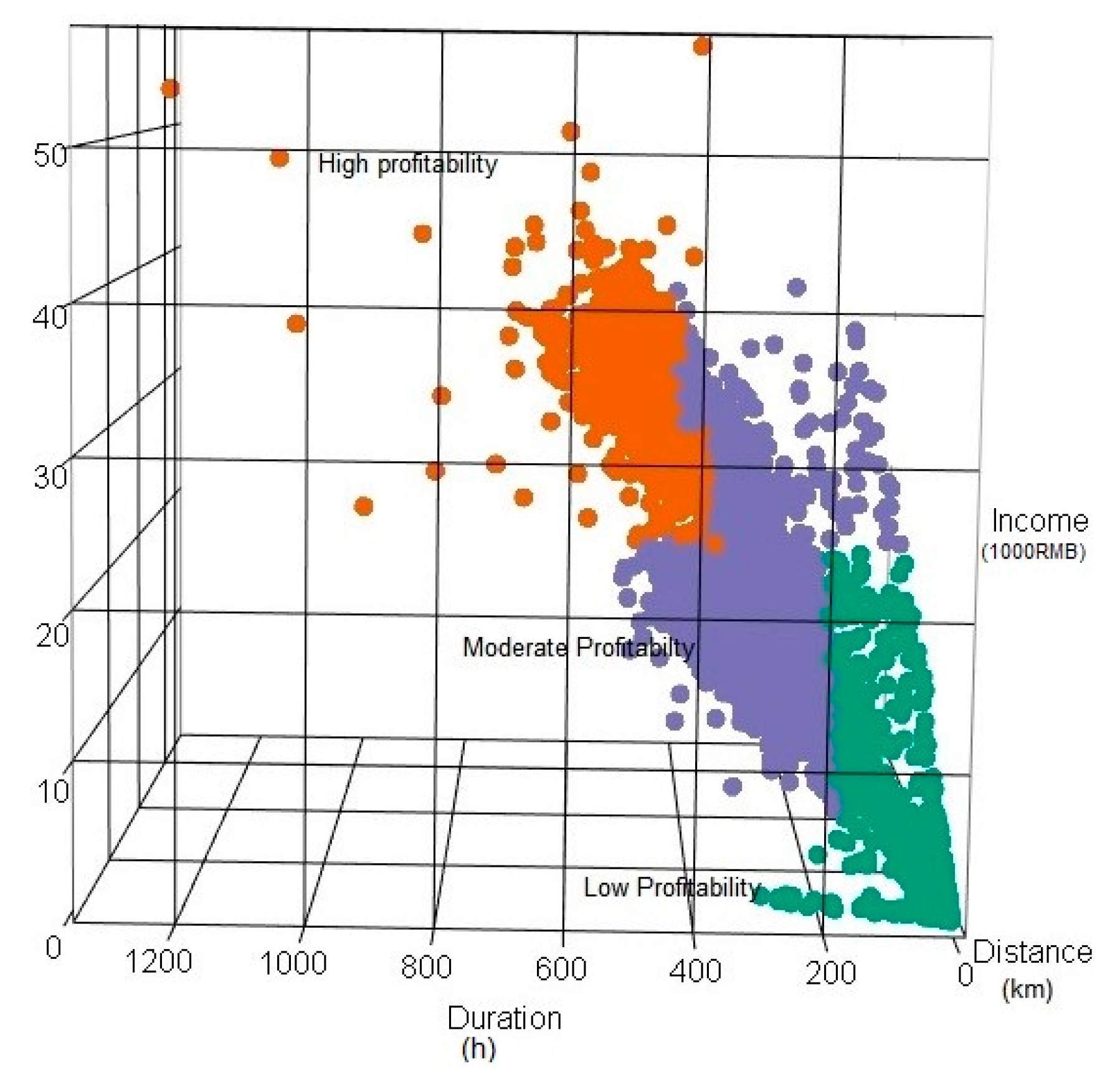


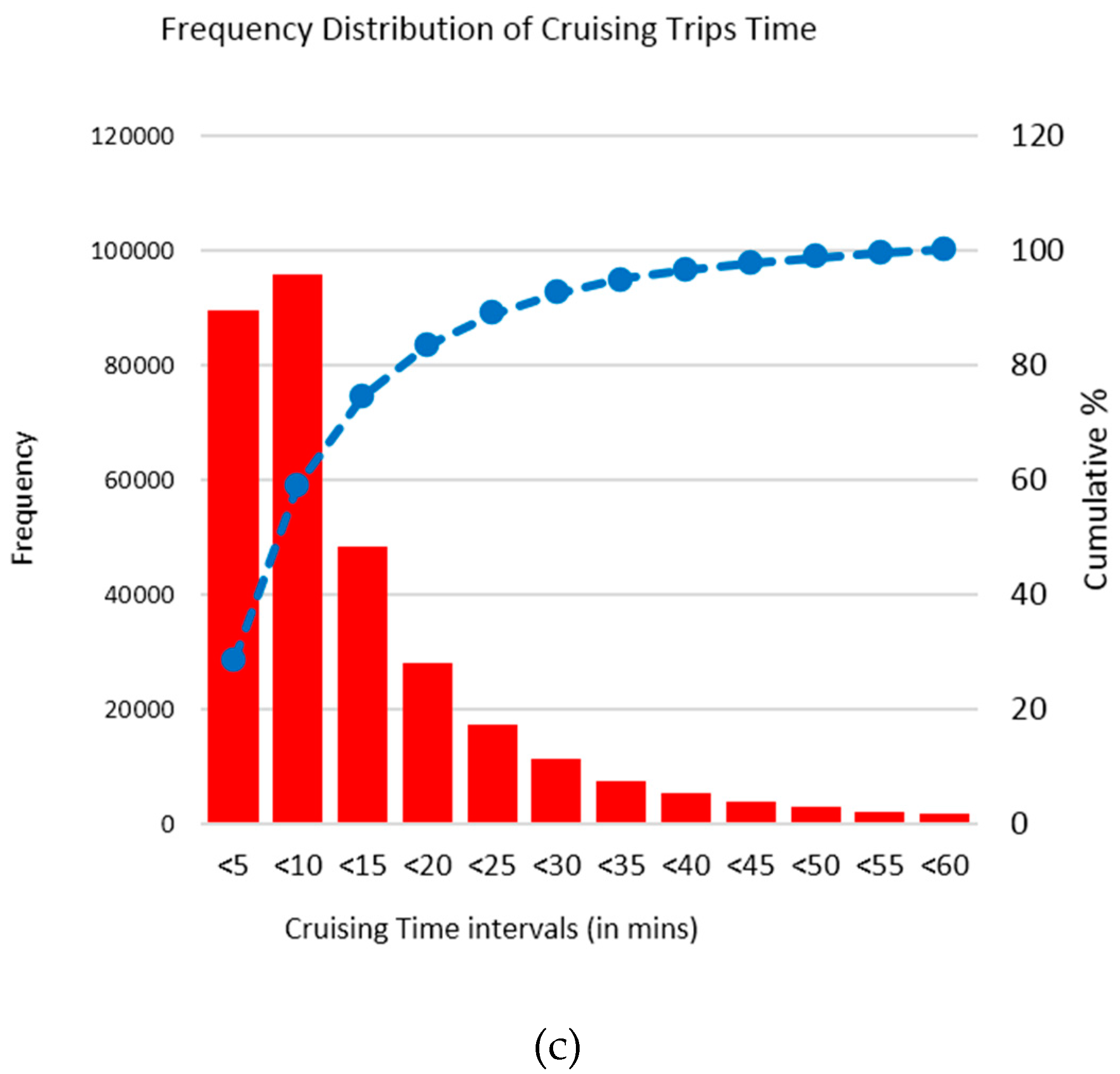
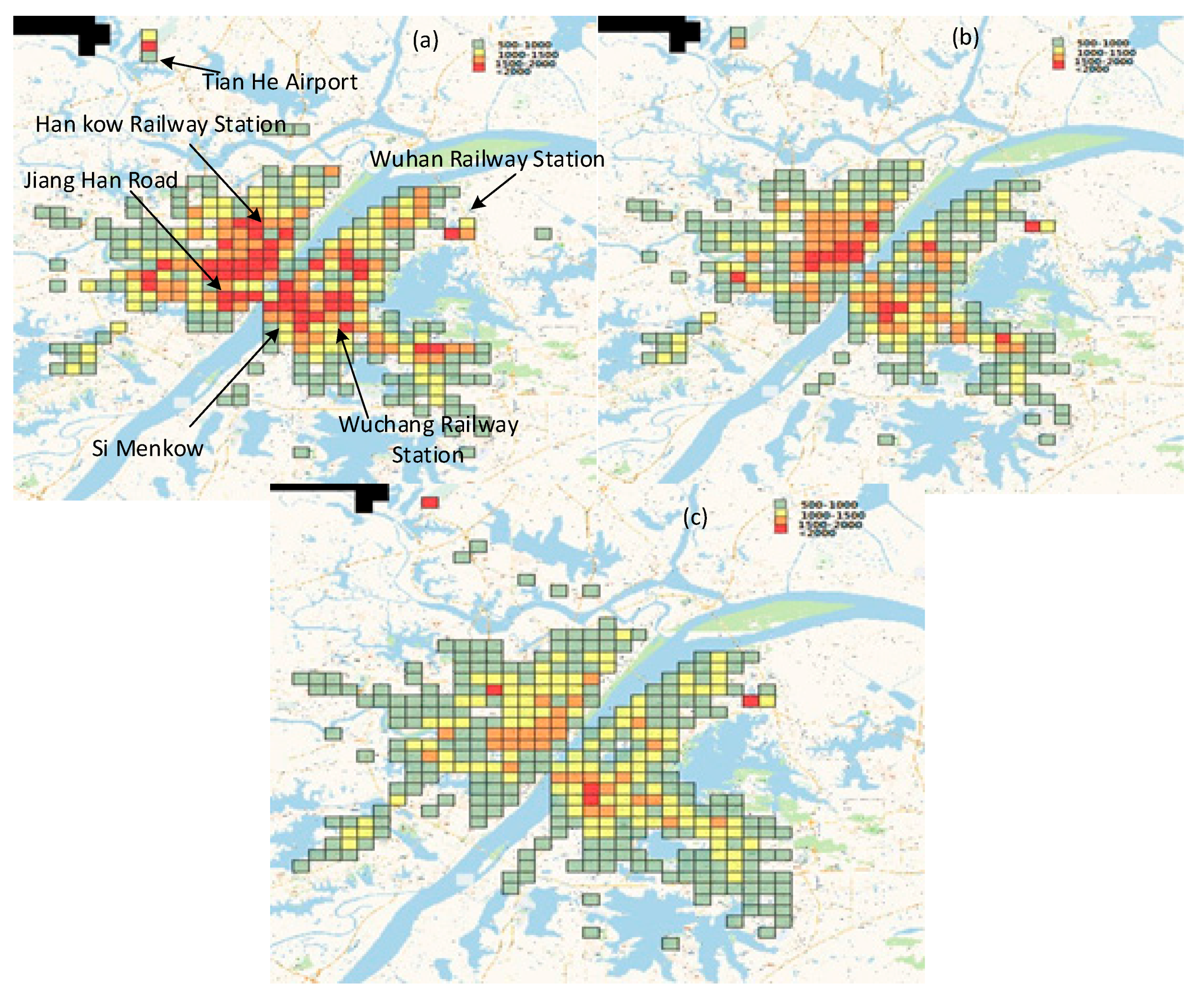
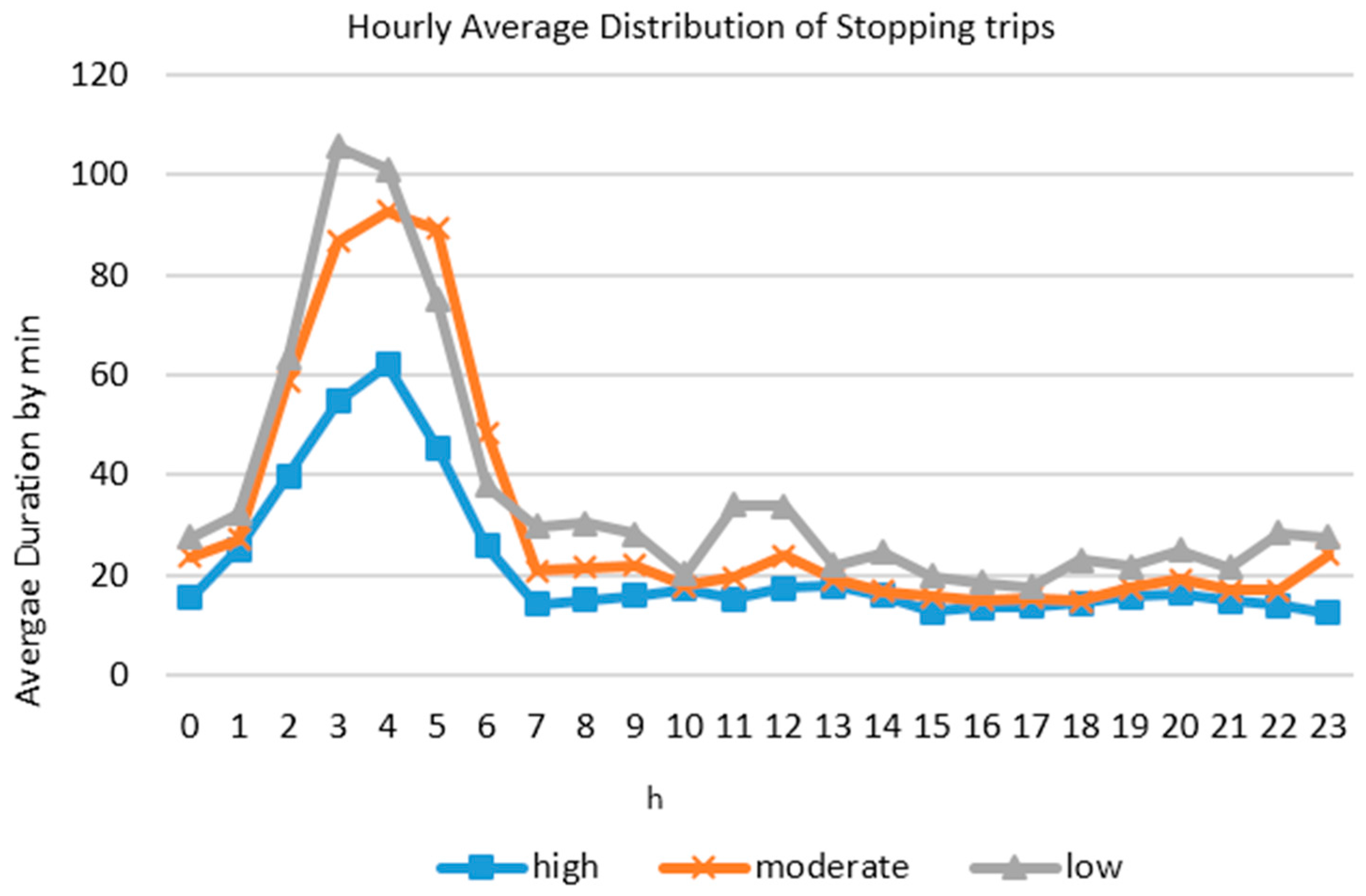

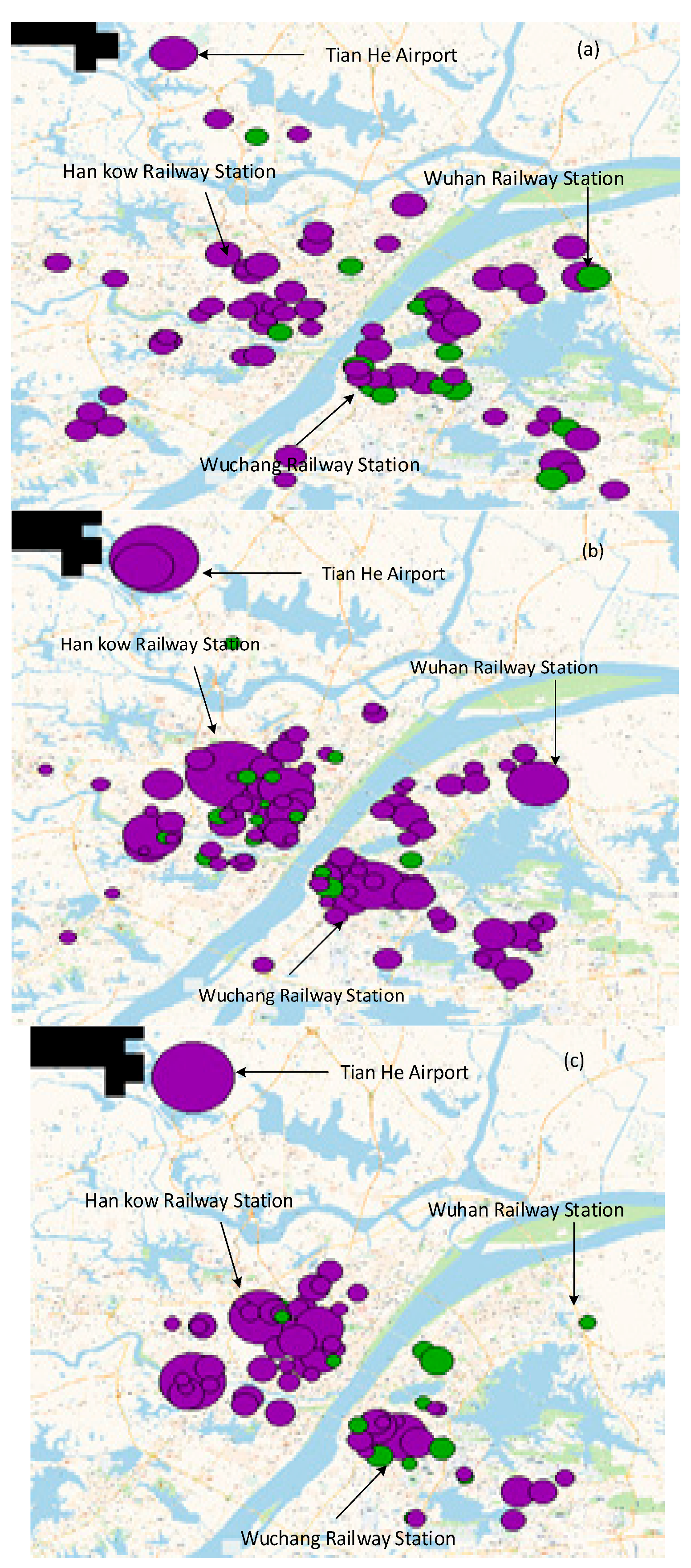

| Field | Value | Description |
|---|---|---|
| Driver ID | 23300123 | 8-digit number |
| Timestamp | 20131001000830 | 14-digit number 1 October 2013 00:08:30 |
| Longitude | 30.587833 | Accurate to 6 decimal places, in degrees |
| Latitude | 114.343916 | Accurate to 6 decimal places, in degrees |
| Velocity | 63.6 | in km/h |
| Car Status | 0, 1, 2, 3 | 1, not occupied; 2, temporarily stopped; 3, occupied; 0, GPS device signal is invalid |
| Taxi State | Description | |
|---|---|---|
| Occupied (O) | A taxi is loaded and occupied by a passenger | |
| Vacant (V) | Cruise (C) | A taxi is traveling without a passenger |
| Stopping (S) | A taxi is static without a passenger | |
| Item | Price | |
|---|---|---|
| P0 | Within 2 km | 6 Yuan |
| P2 | Within 2–7 km | 1.5 Yuan/km |
| P7 | Exceed 7 km | 2.1 Yuan/km |
| FS | Extra Oil Surcharge | 2 Yuan/trip |
| Taxi ID_Tripid | Trip Duration | Trip Spatial Data | Fare | ||||
| Pick-up Time | Drop-off Time | Duration (min) | Pick-up (log, lat) | Drop-off (log, lat) | Distance (km) | ||
| 2618113_1 | 00:51:34 | 01:00:53 | 9 | (30.550, 114.316) | (30.593, 114.258) | 10 | 22 |
| 2871041_3 | 06:27:59 | 06:54:13 | 27 | (30.968, 114.229) | (30.557, 114,210) | 20 | 42.8 |
| 1020463_8 | 13:16:45 | 13:55:49 | 39 | (30.772, 114.206) | (30.593, 114.339) | 36 | 76.4 |
| Profitability Groups | Number of Drivers | % | Mean of Driving Profitability Features | ||
|---|---|---|---|---|---|
| Distance (km) | Duration (hours) | Income (1000 RMB) | |||
| Low group | 844 | 18 | 2.05 | 76.5 | 8.69 |
| Moderate group | 2116 | 45.1 | 6.6 | 288.2 | 18.8 |
| High group | 1722 | 36.7 | 9 | 450.5 | 30.3 |
| Profitability Level | Occupied | Cruising | Stopping |
|---|---|---|---|
| High | 298,779 | 314,086 | 32,668 |
| Low | 230,678 | 300,621 | 28,120 |
| Moderate | 287,801 | 358,364 | 32,225 |
© 2017 by the authors. Licensee MDPI, Basel, Switzerland. This article is an open access article distributed under the terms and conditions of the Creative Commons Attribution (CC BY) license (http://creativecommons.org/licenses/by/4.0/).
Share and Cite
Naji, H.A.H.; Wu, C.; Zhang, H. Understanding the Impact of Human Mobility Patterns on Taxi Drivers’ Profitability Using Clustering Techniques: A Case Study in Wuhan, China. Information 2017, 8, 67. https://doi.org/10.3390/info8020067
Naji HAH, Wu C, Zhang H. Understanding the Impact of Human Mobility Patterns on Taxi Drivers’ Profitability Using Clustering Techniques: A Case Study in Wuhan, China. Information. 2017; 8(2):67. https://doi.org/10.3390/info8020067
Chicago/Turabian StyleNaji, Hasan A. H., Chaozhong Wu, and Hui Zhang. 2017. "Understanding the Impact of Human Mobility Patterns on Taxi Drivers’ Profitability Using Clustering Techniques: A Case Study in Wuhan, China" Information 8, no. 2: 67. https://doi.org/10.3390/info8020067





